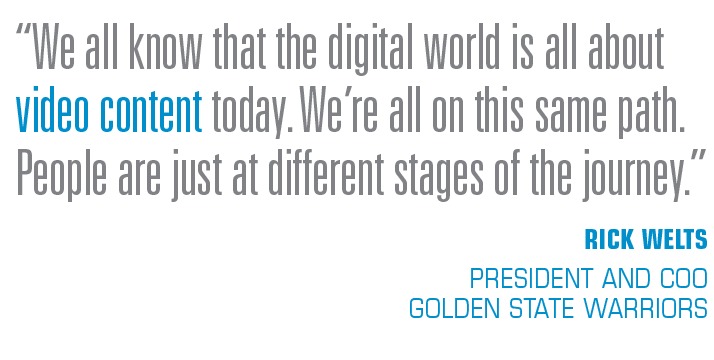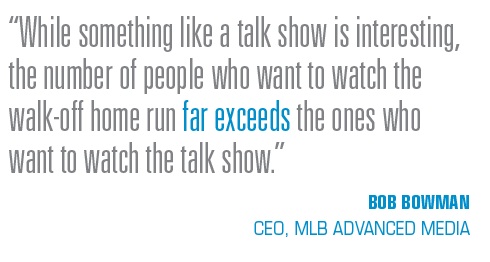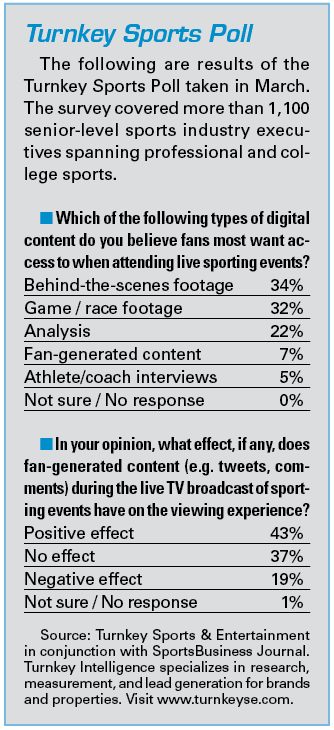Mike Vogel was enjoying a postgame beer after a Washington Capitals home game when a colleague pulled a video camera from a bag and handed it across the table.
“Just let your imagination run wild,” said the visitor, who worked with the Web developer that operated the Capitals website, for which Vogel edited and wrote. “I’m not going to tell you how to use it or what to do with it. It’s up to you guys to figure it out.”
The year was 2000. About half of Americans surfed the Internet, but fewer than 5 percent had broadband connections. Wild as he might run — from a nutty 20-minute player interview shot entirely while playing ping-pong, to a sit-down with Commissioner Gary Bettman — few fans had enough bandwidth to watch what Vogel produced.
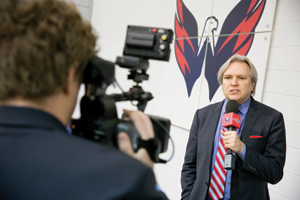 |
Mike Vogel reports from the Washington Capitals practice rink as James Heuser tapes the segment, which was available on the team's website and the umbrella Monumental Network.
Photo by: Nick Griner |
Fast forward to a Tuesday morning last month, at the Capitals practice rink, where the team had finished a 10 a.m. skate in preparation for the night’s game against the Carolina Hurricanes. Vogel stood along the boards in front of a camera, outlining the keys to the upcoming game in a 3-minute video called “Rinkside Update,” which was posted on the Web in time for fans to watch at lunch.
Working with producer James Heuser, who cut his teeth making skateboard videos for his older brother, Vogel also shot locker room interviews with several players and a 5-minute pregame show with radio play-by-play announcer John Walton. Those, along with comments from coach Adam Oates, would be edited and available for the Capitals’ legion of digitally voracious fans to watch on their desktop computers, tablets and phones by 1 p.m.
This is the daily drill for a growing number of teams across the NHL, NBA, NFL and MLB. Teams long have seen a healthy online market for their game highlights. But increasingly, they’re providing daily coverage, mostly to fill a void created by the erosion of mainstream media, but in some cases with the hope of turning traffic into revenue.
An average of 75 million people in the U.S. watch videos online each day, totaling about 38.7 billion video views per month, according to tracking service comScore. A study released last month by Deloitte found that 26 percent of Americans now own a laptop, a smartphone and a tablet. Among tablet owners, 25 percent said they expect to watch more “professionally created Internet content” on the device this year and 21 percent said they plan to watch more sports.
Capitals owner Ted Leonsis has spent more than a decade pushing his franchise to the leading edge of digital content production, no surprise considering the pioneering work at AOL that made him a fortune. The emergence of video as the Web’s killer app and the tablet as a popular device have made it clear to Leonsis that the walls that separate traditional television from the Internet are coming down.
And so, in January, Leonsis launched the Monumental Network, a digital hub that will tie together content from his four properties — the Capitals, the Wizards, the Mystics and the Verizon Center — as well as from others looking to benefit from increased distribution. Monumental has talked with Leonsis’ alma mater, Georgetown, as a possibility. And it is close to a deal to stream D.C. United games that aren’t available on local TV. Monumental’s programming plans could extend to several small colleges and, potentially, area high schools.
Leonsis smiled as he described a vision for streaming Caps and Wizards games on Monumental when those rights deals
eventually come up; Comcast SportsNet Mid-Atlantic holds Wizards rights for eight years after this season and the Caps are up in four years after this season. Eventually, Leonsis wants to turn the broadband offering into a regional sports network similar to MSG and Altitude, with distribution across the region’s cable systems and telecommunications companies.
“For us, it’s part of something bigger: We want to be ready to make a big network when we get our rights back,” Leonsis said last month, outlining the strategy before a meeting with his ownership group partners. “But if, on the way to that, we can create a new property that can be $5 million or $10 million [in revenue], that’s great.”
With three teams and a building under his umbrella, he’s further along toward being a media company than most. Still, many in sports question whether the economics of online distribution will outstrip those of a rights deal, even for a team owner with all those assets under one roof.
For now, that new property lives entirely on the Web, fed by shoulder programming featuring Caps and Wizards content
— interviews from morning skates, shootarounds and postgame locker rooms; analysis by Vogel and others; features on players current and past; and the sort of magazine shows traditionally aired by a team’s broadcast outlets. There’s also a daily studio show, “Monumental Today,” which runs five to 10 minutes, setting up the day for fans of both teams, often with lighter features.
Many teams view their Web content as promotional, a way to deepen engagement with their fans. Leonsis says he agrees with that, but he also sees it as commerce.
Once ramped up, Monumental hopes to have 100 fresh, relevant videos available for viewing at any given time on the network and other, broader platforms. Revenue will come from advertising, with rates set by impression and commercial spots airing at the beginning of most of its videos and dropped into the middle of longer ones.
Penciling out the potential, Leonsis suggests Monumental could bring in $10 million annually, even before launching as a traditional RSN. He points to comparisons to radio, where games often attract fewer than 10,000 listeners, and television, where only the bigger games are viewed locally by more than 100,000 people.
“I remember when Alex Ovechkin scored ‘The Goal,’ that was viewed well over 1 million times [on YouTube],” Leonsis said. “And I laughed. That was a great example. Everyone got the benefit of that but us. It was an unbelievable goal. And on YouTube it was seen millions and millions of times. Well, we want that on our network.”
With video as the gateway, Leonsis believes the Monumental site can get to 5 million or 10 million page views a month, which is a long way from the 1 million views it’s getting three months in.
At the other end of the country, not far from ground zero of the digital revolution, the NBA’s Golden State Warriors are placing a similar emphasis on original video.
Ownership there isn’t talking about an RSN yet, but it has built out its menu of quality video offerings, hiring former TV anchor/reporter Laurence Scott to produce features that are up to the standards of a network affiliate. On a trip to New York to cover the draft, Scott visited the boyhood home and high school of coach Mark Jackson. At the All-Star Game in Houston, he chronicled the experience of Warriors players and interviewed Warriors fans.
Like many in sports, the Warriors also got their piece of one of the world’s viral video crazes, cutting a “Gangnam Style” video that has clocked in with more than 3 million views, which sounds like an extraordinary event until you consider that the Miami Heat’s “Harlem Shake” video is at 42 million and counting.
“We all know that the digital world is all about video content today,” said Rick Welts, Golden State Warriors president and COO and former head of NBA Properties. “We’re all on this same path. People are just at different stages of the journey.
“There can’t be any more important issue. We sit in the catbird seat because we have the content. Over time, the means of distribution of that content evolves. A lot of fortunes are made and lost placing bets on distribution.”
Taking the long view
The man Leonsis has put in charge of this Monumental effort was with him at AOL, where he served as the company’s general counsel. As Randall Boe sees it, Monumental is pushing the edge of all this for two reasons. With three teams in a large market, they have a more compelling argument for an RSN than most. But he also believes their AOL roots give them a different perspective from most owners.
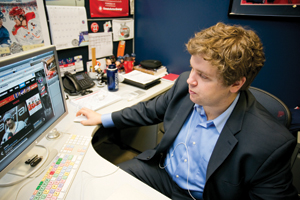 |
Back at the office, Heuser edits video shot at the Caps' morning practice.
Photo by: Nick Griner |
“From the beginning, we came at this with the thought that the teams are a source of content,” said Boe, who was instrumental in Leonsis’ purchase of the Wizards and Verizon Center from the estate of former owner Abe Pollin three years ago. “There is a host of content we can develop — and not just content to market the teams, but content people would be interested in.
“If a ‘Gangnam Style’ video can generate more than a billion views; if there can be 50,000 versions of the ‘Harlem Shake’ video — those seem like trite, silly examples, but I think what they show is the power. There’s not really a ceiling to the viewership you can get if you develop really compelling content.”
Of course, those who expect viral home runs like “The Goal” by Ovechkin or the Heat’s “Harlem Shake” to come with any frequency would be sorely disappointed at this point.
|
| Once ramped up, Monumental Network hopes to have 100 fresh, relevant videos available for viewing at any given time. |
While the game highlights that live on the respective league sites can do big numbers — the clip featured on MLB.com’s front page typically gets 200,000 to 300,000 plays by 11 a.m., according to MLB Advanced Media CEO Bob Bowman — the interviews and features that the teams produce fall well short of that.
Nobody has gotten a clearer view into fans’ online consumption habits than Bowman, who has been watching traffic on both the MLB.com home page and all 30 team sites for a decade. With about 11 million unique visitors a day generating about 150 million page views, MLBAM plays to a vast and engaged audience. About 65 percent of MLBAM’s 10 million video plays a day are of game highlights, Bowman said, while about 15 percent come from interviews and other shoulder programming.
“We play every day, so we have 15 feature-length movies every day,” Bowman said. “That content is so special, so unique, so invigorating — and that’s what all the other content that we create each day competes against. When a fan picks up that iPhone in the morning, we better have the highlights up.
“While something like a talk show is interesting, the number of people who want to watch the walk-off home run far exceeds the ones who want to watch the talk show.”
The reality is that, other than for highlights, most of the videos produced by teams as part of their daily coverage register in the range of 1,000 to 2,000 views.
Monumental executives say viewership of Capitals and Wizards content varies wildly, based largely on opponent and, in the case of postgame coverage, whether the team won.
Pregame player interviews generate 500 to 2,500 plays. Postgame news conferences get 1,000 to 10,000. Pregame analysis shows get 500 to 2,500.
In general, the Caps’ afternoon lineup on a game day checks in at 1,500 to 2,000 starts.
None of this comes without a cost, but the costs can be minimal. Heuser shoots all of the Caps’ video, edits the footage and drops in graphics using Mac Final Cut, then posts it. His position and Vogel’s have been in the Caps budget since they took the site in-house in 2001. This season, knowing that they’d need more content to feed Monumental, they made their radio play-by-play job a full-time, year-round position. All three travel to the 41 road games, flying on the team charter. Hotel rooms and meals are the only additional expenses.
“You have to take a step back and believe in the concept,” Boe said when asked why a team should invest in so small a pool. “You can’t just put something up occasionally and expect to get an audience. That’s why you build a network. You’re putting something up every single day, several times a day, so you’re getting people in the habit of coming back every single day.
“Does that require commitment and management that’s willing to take the long view? Yes. And that starts with believing this is a viable business.”
The first phase of that build-out was the creation of the network, with a common look and feel that would tie together video from the websites of the three franchises and the Verizon Center. The Monumental logo runs as an embedded “bug” on most videos, regardless of which team it comes from or on which site it appears.
The teams also took all of their video production in-house. A staff of 19 churns out about 21 hours of video each month that airs on Monumental Network, on the sites of all three teams, in the arena and in promotional materials. They also provide about 100 hours a month of live game and event production.
Monumental’s studio shows are shot on the upper level of Verizon Center, behind a nondescript door across from an ice cream stand. The room last hosted a woodworking shop for the crews that renovated the building’s suites.
With a set procured almost entirely from a trip to Ikea, Monumental produces shows on par with many that air on traditional RSNs. Before adding the studio, the Caps were shooting in a suite, which required four hours of setup and tear-down. Now a crew of three — including talent — can shoot a show on a flash media drive, produce it in a control room downstairs and post it online, all in less than two hours.
Rob Hedrick, who heads up television operations for Monumental, has drafted plans for a far more elaborate studio in the same space at a price upward of $500,000. Monumental has discussed sharing it — and the cost — with Comcast SportsNet.
“You have to build a platform that you can monetize and then you have to make the investment in it,” Boe said. “If you just generate content and put it out there on Facebook, you may get a lot of likes but you haven’t really created a business yet. So what we’ve done is create a business around it. The idea is for it to not just be self-sustaining but to contribute to the Monumental Sports bottom line relatively quickly.”
Less than 10 weeks after flipping the switch on Monumental Network, Boe said they’ve already seen signs that the model is working, as evidenced by the increased traffic. Fans are becoming increasingly aware of Monumental, pushed there by the highlights on the team site that they were already in the habit of watching.
“We get it out there [on the team sites] because we want the views,” said Mike Hutchinson, senior director of digital media for Monumental, who previously headed new media for the Wizards and Mystics. “We use that to get people there and then we try to engage them with other stuff. If we know somebody is going to watch a video, the next video is going to be a promotion for something you’re going to see on the network. We’d love to have all those views for ourselves, but we’re already monetizing them [on the league-housed team site]. So we start them there and then move them along.”
Boe projects that they will surpass 1 million unique visitors a month once they integrate the Verizon Center website into the network later this month.
From there, it will be a matter of selling on the back of those numbers.
Monumental’s corporate partnership group employs 10 service representatives and seven sales representatives, including two recent additions with strong digital backgrounds to focus on the network.
Creating the network has opened an advertising market that the teams were missing before, said Tom Hunt, senior vice president of corporate partnerships for Monumental.
“In the past we probably left a lot of money on the table because we wanted to protect our marks,” said Hunt, who came to Monumental from the Sacramento Kings, where he was senior vice president of corporate partnerships. “We wouldn’t have done deals that might have been $5,000, $10,000 and $15,000, which seem to be out there today. Now, we can.
“They don’t get the rights to the [team] marks. But they get access to the network that speaks about that content.”
As Monumental builds its programming menu, it plans to incorporate more that plays off events at the building, such as concerts. Leonsis would like to stream more music-related video, similar to the way Madison Square Garden has broadened its flagship RSN. He’d like to do more food-related content to attract advertising from local restaurants.
Leonsis likes to tell the story of a recent trip to a nearby Legal Sea Foods to get a bowl of soup on a chilly, gray afternoon in November. When he took out his wallet to pay, the general manager stopped him, saying his money was no good there, a thanks for bringing so much business to his door.
Making conversation, Leonsis asked if the restaurant advertised with the teams or the building. The man said it didn’t. Season tickets? Nope. Suite? Oh, no, the man said.
“Soooooo, basically, we bring 3 million people a year down here for you,” Leonsis said to the man. “You pay a lot of money to a landlord.
“And I get a cup of soup.”
Leonsis chuckled as he delivered the punch line, but the larger story clearly is one that vexes him. Now that he is in the business of not only hockey, but also basketball and everything else that comes through the arena, he intends to take a broader view of content.
That’s similar to the point of view the Warriors have taken, in large part at the behest of co-managing partner Peter Guber. An award-winning film and TV producer whose Mandalay Entertainment company long has held stakes in minor league baseball and now is an investor in the Los Angeles Dodgers, Guber has pushed Warriors executives to think of their website more as a television outlet, and to program it accordingly.
Not only is there coverage of games and shootarounds, but the Warriors video page — which the team promotes as Warriors TV — also includes related content from beyond the team, such as a recent feature on former Stanford player Mark Madsen, who now is an assistant coach at the school.
“You have the opportunity to curate material that’s larger than just your team,” Guber said. “You have people who are interested in the Warriors. In basketball. In basketball in Northern California.
“It’s not a question of what’s interesting. It’s what they’re interested in that’s the key.”
Does the math work?
Clearly, Leonsis’ view of Monumental Network stems from a different set of objectives than most sports franchises have
when they consider their investment in online content.
Yet several challenges exist before Leonsis can turn Monumental into a full-fledged RSN. For starters, the channel would have to sign carriage deals with the area’s cable, satellite and telecommunications operators, which is easier said than done.
In some markets, like Los Angeles, the programming has been popular enough to force local distributors to carry the channels. In other markets, like Houston and Portland, the programming has not been popular enough to convince most local distributors to carry it. It’s not clear whether Wizards and Capitals programming is popular enough in the D.C. market to coerce distributors to carry a high-priced RSN.
Another potential snag comes from programming. It’s one thing to supply a couple of hours of shoulder programming per week around the teams. It’s another thing to program a full 24/7 TV channel, where production values have to be higher and production costs are significantly more expensive.
Currently, Comcast SportsNet Mid-Atlantic and Monumental work together. The two share programming and resources. From Comcast’s point of view, it believes Monumental can operate as a complement to its television and online offerings.
Even Dallas Mavericks owner Mark Cuban, who made his fortune flipping a company that streamed live audio and now owns AXS TV, is skeptical of teams doing their own distribution.
“The challenge is the value proposition,” Cuban said via email. “Our content is worth more as live tent pole programming to an aggregator of content, regardless of platform, than it is to a singular audience. I don’t see that changing.”
Still, the vast majority of properties, including the Mavs, increasingly are looking to video as programming, and at the video section of their website as something more akin to an engine than a sidecar.
“Video is the killer app on the Internet,” Leonsis said. “If you were starting day one, blank slate, this is what you would launch. You’d be digitally sound and be ready for cable.
“That’s what we’re building.”
Staff writer John Ourand contributed to this report.



